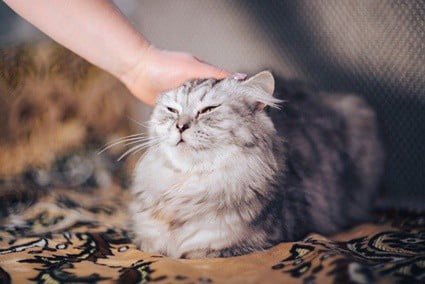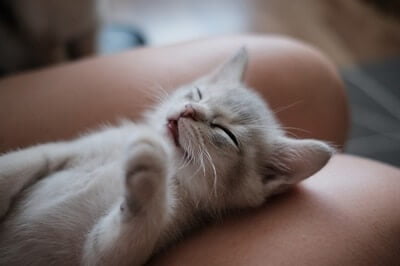Many owners liken their cats to children. They love to take care of them, cuddle them, and provide them with a safe living environment. Cat moms and dads often talk to their pets in a high-pitched, childlike tone, while others enjoy scooping up their cats and cradling them like a baby.
It’s OK to carry a cat like a baby if it’s well supported and has no spinal injuries. However, most cats dislike cradling because it’s a restrictive holding method that can bring back memories of past trauma. It can also be worrying and uncomfortable. However, affectionate cats may enjoy being held belly-up, if only for a short while.
If your cat starts to squirm or becomes agitated, put your cat down. Before cradling your cat, you should assess its personality. If your cat is independent and aloof, it will likely become agitated. Cats with more relaxed and placid characters are more likely to allow you to pick them up in this way.
Is it Okay to Carry a Cat Like a Baby?
Owners can carry their cats like babies, but only if the cat likes it and it’s done safely. There’s a correct physical technique to follow to keep cats safe. Without this, your cat might freak out and become nervous.
To carry your cat like a baby, gently pick it up, place it on its back, and securely cradle it in the crook of your arm to keep it steady. If your cat starts to struggle, put it down immediately. It may begin to correct its position or even lash out to release itself from your grip. This means that your cat has had enough.
Remember that some cats will never enjoy being picked up in this way, despite how often you try. If your cat becomes stressed while behind held on its back, you should avoid this in the future.
Risk of Physical Harm
Picking your cat up and placing it belly up gives it easy access to your face. If your cat becomes agitated because it wants to get down, you’re putting yourself at risk of being scratched. Not only will this hurt, but the marks will be on display for everyone to see.
If your cat has a painful spine, carrying your cat like a baby will cause additional harm. This carrying technique requires strong spinal support. If your cat has an injury or is feeling fragile, this might make it worse.

The Slow Blink Test
Before picking your cat up like a baby, try the slow blink test to see how affectionate and trusting your cat is feeling at that moment. It’s best to avoid picking up a cat that is not in the mood for it, or you might end up getting hurt.
Relax your face and blink very slowly at your cat. Don’t stare at your cat, though. Keep your eyes soft and relaxed. If your cat returns the love by blinking slowly back, it is ready to be picked up. If it doesn’t return the blink or becomes riled up, it’s best to wait until your cat feels calmer and more relaxed.
Do Cats Like Being Carried?
Whether or not a cat likes being picked up comes down to its unique personality. Certain breeds, like Ragdolls and Ragamuffins, enjoy being picked up and held. Cats that are affectionate and docile will love sitting in their owners’ laps and won’t mind having a cuddle.
Other breeds, including the Russian Blue and American Wirehair, are fiercely independent and prefer to be left alone. They will start to wriggle and squirm when they’re picked up and may run away once they’re placed back down. Cats with this kind of temperament are unlikely to change. Here’s why a cat won’t want to be picked up:
Cats Are Easily Scared
If a cat is easily startled, picking it up might cause stress. It can be scary for a cat to be scooped up by someone much larger. In response, your cat might run away and hide under a bed or other small space where a human can’t reach it.
In the worst cases, your cat might become more fearful of noises or sudden movements, leading to a whole host of problems, including furniture scratching and soiling the house.
Cats Dislike Restraint
While an owner might mean well, cradling a cat like a baby may cause it to feel suffocated. If it cannot get away or move freely, it may panic. Cats, whether naturally independent or not, will feel trapped, especially strays or rescue cats.
You’re Disrupting Your Cat’s Instincts
Most cats like to jump or climb to high perches. These expert jumpers have refined their skills over thousands of years of evolution. Many cats don’t appreciate being picked up as it takes away their independence.
Cat Has a Troubled Past
Rescued cats sometimes have a troubled past. If their owners were abusive or had a rough life living on the streets, their history might make them fearful about being picked up.
But it’s not just cats that have had a troubled past that can be wary of being held. Even one bad experience of being dropped can trigger feelings of stress and anxiety. Some cats can be re-trained to enjoy a cuddle, while others will never overcome their fears.
It Doesn’t Feel Natural To Your Cat
Being plucked into thin air isn’t a natural feeling for cats. It might also unlock deep subconscious feelings of being taken by a predator, leading to trust issues or even feelings of trauma.
Cat Is in Pain
If your cat is hiding an injury, picking it up will make it worse. It may alert you by meowing in pain or scratching you to let it go. Once it associates the action of being picked up with pain, it’s unlikely that the cat will let you do it again.
Why Does My Cat Like to Be Held Like a Baby?
Some cats enjoy the comfort and warmth of this holding position. Affectionate cats that like to be close to their owners will also love the closeness that this holding maneuver can bring. Cats that have been handled from when they were a kitten and enjoyed being picked up are more likely to enjoy being carried. Some cats love to be babied.
While it’s rare to find a cat that allows itself to be babied by its owner, these cats do exist. If a cat has built a healthy trust level with its owner, it will feel more comfortable when picked up. It may even play along with pretending to enjoy the hug, even if it wants to get down.
Also, cats are intuitive and can pick up on human emotions. A study published in Animal Cognition found that cats behave differently when their owners smile compared to when they frown. Owners who smiled more were more likely to purr, rub against their owners, and spend more time close to them. If you want to try a belly-up hug with your cat, try smiling and displaying other positive emotions to encourage your cat to play along.
Does My Cat Think It’s a Baby?
It’s explained in PLOS One that owners should treat a cat like a young child. Some owners might take this advice a bit too seriously, leading to their cat adopting childlike traits and bad behaviors. Being held like a baby will, therefore, become a part of a cat’s normality.
While cats understand that a human is not its mother, they show us affection and respect similarly to their mothers, displaying behaviors that some humans mistake for baby-like traits.
Kittens, in particular, rely on the interactions of those around them to help shape their personality. If an owner treats it like a baby from a young age, its nature may develop to enjoy affection and attention. It might also want to be close to its human more than a cat that isn’t used to this kind of human interaction.
How To Properly Hold Your Cat
When it comes to holding your feline friend, there is a proper way to handle them. When approaching your cat, you should support it by placing one hand under its chest and the other under the abdomen. This allows your cat to feel comfortable while reducing the risk of injury.
Squish your cat into your body to keep it close. Move your hand to create a platform for its paws to rest on. This will keep your cat feeling safe and secure while preventing it from breaking itself free from your grip. It makes the hold more comfortable, too. However, your cat might find it comfier to sit over your shoulder instead.
Your cat might not stay put for long. But even if the cuddle only lasts for a few short minutes, you can still build a secure connection with your pet.
Things To Do
- Make sure your cat is comfortable. If it is starting to become agitated or aggressive, put it down.
- Keep your cat’s body weight supported by firmly supporting its chest with your hand.
- Support the hind legs and feet with your hand. Don’t leave them to dangle.
- Hold your cat close to your body so that it feels more secure.
Things Not To Do
- Turn your cat belly up if it seems vulnerable or stressed. Many cats don’t take to being cradled.
- Pick your cat up if it has a spine injury.
- Squeeze or trap your cat. A firm grip is fine, but don’t hold it too tightly.
- Resist if your cat starts to squirm. This is a clear sign that it wants to get down.
While cats rarely see themselves as babies, their human owners may do. And this is why owners treat their cats like children, forgetting that their cats might not appreciate the hugging and fussing. Some cats are more affectionate than others, so you need to gauge your cat’s personality.

